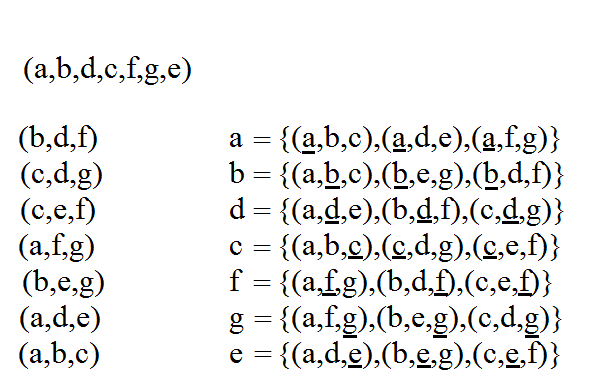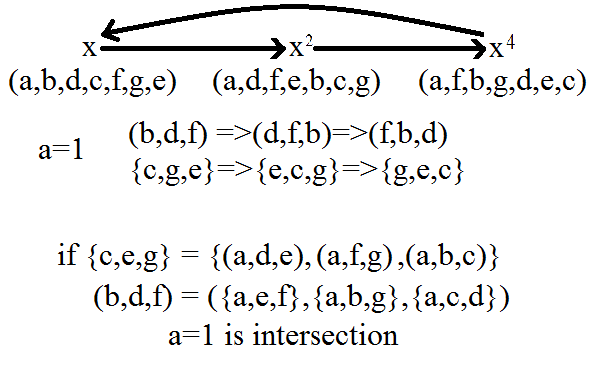Revelation
|
 Last Three Seals - Alignment
The maths of the seven seals had me a little perplexed. If the first four seals correspond to the left/right pairings of unity ('a' say) to one of the four groups [0,b,d,f],[0,b,e,g],[0,c,d,g],[0,c,e,f] (the ones that do not contain 'a') Then we do not see the math of the four horsemen, crown, sword, scales etc so easily.
What of the last three seals that contain the element 'a' in their correspondent subgroups? Clearly no group containing 'a' is held fixed under frobenius if a=1. We could just as correctly say, what of the elements b, d, or f in the fixed group (b,d,f)? as we have before. (I like working with "a" here, although b = 1 = (b,d,f) would be appropriate)
for instance
a = [0,a,b,c] is unity
b = [0,b,d,f]
d = [0,c,d,g]
c = [0,c,e,f]
f = [0,a,f,g]
g = [0,b,e,g]
e = [0,a,d,e]
under frobenius these associations would send
a=>a
b=>c=>b
which gives rise to a contradiction, and not as frobenius. Since the frobenius map is "cyclic order 3".
but under the complement octal when a=1 and (b,d,f) is static (as our "lampstand") we could legally have
a = [0,c,e,g] is unity
b = [0,a,e,f]
d = [0,a,b,g]
c = [0,b,d,e]
f = [0,a,c,d]
g = [0,b,c,f]
e = [0,d,f,g]
but when altered to align with 'a' = [0,a,e,f] or others we would have the same contradiction. There then appears to be trouble unless we use the C7 element associations of our right hand octal to the subgroups (triples) of the left hand: yet this gives rise to infinite descent unless we take groups of subgroups under K4 addition and associate these groups of subgroups with their single element intersection, i.e. to associate "a" with a group [0,(a,b,c),(a,d,e),(a,f,g)]. Then we may never align "a" with a subgroup (a,X,Y).

Likewise we could easily consider a new model where we take a subgroup X and map it under an ordering of a seven cycle element 'sigma'. We could scramble the seals if we so wished to make things work out: but then we would arise at another correspondence. We would not be preserving the same lampstand that is being used here, i.e. the seven lamps of fire that correspond to the church letters of Christ as in the mystery of the seven candlesticks.
The answer is frobenius again.

It became apparent after prayer that the last three seals do actually have these correspondences, but there is no way in the octal to perform this operation. (at least not with elements - we have more luck with subgroups.)
Instead we can readily switch to the "Sit at my right hand" part of the ultrafilter, where we consider the trinity as members of GF(4) instead of GF(8).
Thus, if
a = [0,a,b,c] is unity
b = [0,a,d,e]
c
= [0,a,f,g]
we can recover both K4 and C3 from the ultrafilter easily enough and there is no problem. It is then the case that as this is never true for individual elements, but only a self referencing group and not true for the octal itself on the basis of its elements, then only this K4 group as Christ can unseal these seals - the "lion of the tribe of Judah has prevailed to take the book and loose the seals thereof" and He is the only one to do so. Here the subgroup fixed is just [0,a,b,c] in its GF(4) association as the whole ultrafilter.
The other two fields are similar - but it must be remembered that GF(4) is of degree two over Z/2Z so the frobenius automorphism of the above is;
a = [0,a,b,c] is unity
b = [0,a,f,g
]
c = [0,a,d,e]
So the last three seals correspond to the remaining alignments of unity in GF(4) only. (Don't confuse these with the static subgroup [b,d,f] in the octal to which they correspond!)
a = [0,a,d,e] is unity
d = [0,a,f,g
]
e = [0,a,b,c]
a = [0,a,f,g] is unity
f = [0,a,b,c
]
g = [0,a,d,e]
etc. So, simple enough really. Only Christ could open the last three seals since He has "Life in Himself" apart from existence contained within the Father as all others have.
So what of this "Hell" formed by the four horsemen in the fourfold dialectic? (closure outside of Christ in the four beasts) If a person may ask "Am I in Hell already?" I would answer - You are in God the Father, for in Him we "live and move and have our being",.. "and yes, you are in Hell already." The second death (everlasting torment) is to remain inside the system of the fourfold dialectics after the Father has withdrawn Himself from it (and the agape (charitable, valuable) love is taken away), and leaves behind just those four dialectics. So, to be concluded in unbelief from Christ is to be condemned, and those who are not in Christ are condemned already.
Continue To Next Page
Return To Section Start
Return To Previous Page |